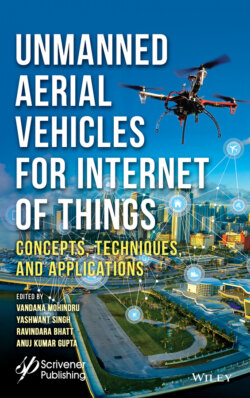Читать книгу Unmanned Aerial Vehicles for Internet of Things (IoT) - Группа авторов - Страница 56
2.2.4 Deployment of UAV
ОглавлениеAnother challenging issue in UAV based communication networks is the deployment of the UAVs. Parameters like the geographical area, location of ground users, altitude of the UAV, etc. play a critical role in determining the performance of UAV-based communications Simultaneous deployment of UAVs causes inter system interference. Both distance and Line of sight probability are to be considered while deciding the optimal altitude. Deployment at lower altitudes poses problems of lower coverage and less probabilities of LoS links due to the shadowing effect whereas UAVs at higher altitudes tend to exhibit poor coverage performances on account of higher path losses because of the large distance between transmitter and receiver [51]. Research work of Refs. [15, 16, 20, 52] discusses the algorithms developed to find the optimal placement of LAP’s, the maximum number of UAVs required to serve all the users on the ground, the impact of UAV’s altitude on the performance of networks, placement of UAV’s for maximizing the coverage etc. Optimal deployment of UAVs reduces the average transmit power of the devices in an UAV-IoT communication network [53]. Also, the number of UAV’s required in such networks is also determined by the altitude of the UAVs [33]. UAVs with directional antennas and higher antenna beam widths perform well even if deployed at lower altitudes. Another challenge lies in determining the continuous UAV trajectory as it involves a large number of variables. A solution to this has been discussed in Ref. [54].
